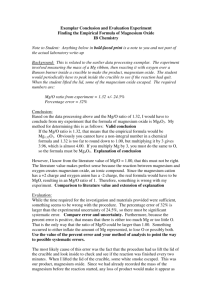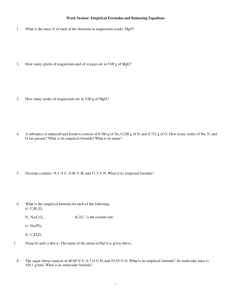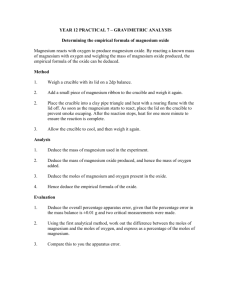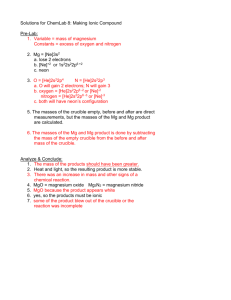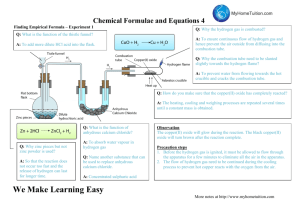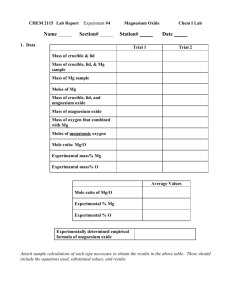Empirical Formula Calculations from Lab Data
advertisement
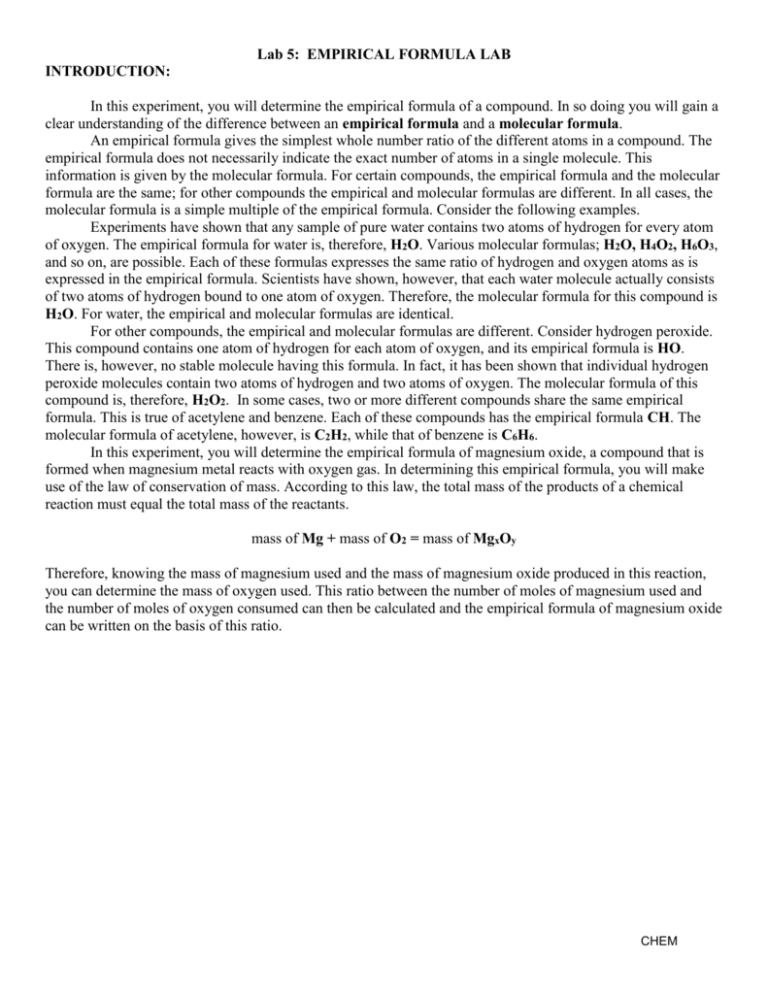
Lab 5: EMPIRICAL FORMULA LAB INTRODUCTION: In this experiment, you will determine the empirical formula of a compound. In so doing you will gain a clear understanding of the difference between an empirical formula and a molecular formula. An empirical formula gives the simplest whole number ratio of the different atoms in a compound. The empirical formula does not necessarily indicate the exact number of atoms in a single molecule. This information is given by the molecular formula. For certain compounds, the empirical formula and the molecular formula are the same; for other compounds the empirical and molecular formulas are different. In all cases, the molecular formula is a simple multiple of the empirical formula. Consider the following examples. Experiments have shown that any sample of pure water contains two atoms of hydrogen for every atom of oxygen. The empirical formula for water is, therefore, H2O. Various molecular formulas; H2O, H4O2, H6O3, and so on, are possible. Each of these formulas expresses the same ratio of hydrogen and oxygen atoms as is expressed in the empirical formula. Scientists have shown, however, that each water molecule actually consists of two atoms of hydrogen bound to one atom of oxygen. Therefore, the molecular formula for this compound is H2O. For water, the empirical and molecular formulas are identical. For other compounds, the empirical and molecular formulas are different. Consider hydrogen peroxide. This compound contains one atom of hydrogen for each atom of oxygen, and its empirical formula is HO. There is, however, no stable molecule having this formula. In fact, it has been shown that individual hydrogen peroxide molecules contain two atoms of hydrogen and two atoms of oxygen. The molecular formula of this compound is, therefore, H2O2. In some cases, two or more different compounds share the same empirical formula. This is true of acetylene and benzene. Each of these compounds has the empirical formula CH. The molecular formula of acetylene, however, is C2H2, while that of benzene is C6H6. In this experiment, you will determine the empirical formula of magnesium oxide, a compound that is formed when magnesium metal reacts with oxygen gas. In determining this empirical formula, you will make use of the law of conservation of mass. According to this law, the total mass of the products of a chemical reaction must equal the total mass of the reactants. mass of Mg + mass of O2 = mass of MgxOy Therefore, knowing the mass of magnesium used and the mass of magnesium oxide produced in this reaction, you can determine the mass of oxygen used. This ratio between the number of moles of magnesium used and the number of moles of oxygen consumed can then be calculated and the empirical formula of magnesium oxide can be written on the basis of this ratio. CHEM Lab 5: EMPIRICAL FORMULA LAB PRELAB QUESTIONS I. Pure copper reacted with oxygen when heated strongly. The following data were collected. mass of copper powder used (g): 25 mass of copper powder and beaker (g): 72.420g mass of copper oxide and beaker (g): 78.714g 1. Calculate the number of moles of copper powder, given a molecular weight of copper equal to 63.55 g/mole. 2. Calculate the mass of the beaker (g). 3. The final mass of copper oxide (g). 4. The gain in mass in the beaker which is equal to the added mass of oxygen (g). 5. The number of moles of oxygen in the copper oxide, given a molecular weight of oxygen (O) equal to 16.00 g/mole (convert 3(c) to moles). 6. Calculate the molar ratio of copper to oxygen (moles copper powder) / (moles of oxygen in the copper oxide). 7. According to this molar ratio, what is the empirical formula of copper oxide? 8. Write a balanced equation for the reaction occurring between copper and oxygen. CHEM Lab 5: EMPIRICAL FORMULA LAB Name:__________________________________ Lab Partner:________________________ SAFETY: Use tongs at all times when handling the hot crucible and lid. Do not look directly at the burning magnesium. Avoid inhaling the fumes produced while heating. PROCEDURE: 1. Clean and dry a crucible and lid and place them on a clay triangle as shown in Figure 1. To dry them, heat strongly for 2 to 3 minutes over the burner. Then let them cool in the desiccator to room temperature. CAUTION: Hot porcelain. Use tongs to handle the crucible and lid throughout the experiment. 2. Record the combined mass of the crucible and lid in your data table. 3. Polish a strip of magnesium ribbon with steel wool until it is shiny. Loosely coil the magnesium strip and record the mass of the magnesium. 4. Place the coiled magnesium in the already massed crucible. 5. Heat the covered crucible gently over the burner. Lift the lid about every 20 seconds to allow air in. CAUTION: Do not look directly at the burning magnesium metal. Avoid inhaling any fumes. 6. When the magnesium appears to fully reacted (~5 min), partially remove the crucible lid as shown in Figure 2. Continue heating for 1 minute. 7. Turn off the burner. Time permitting, after the crucible has cooled to room temperature, carefully add a few drops of water to decompose any nitrides that may have formed. CAUTION: Use care when adding water. Too much water can cause the crucible to crack. 8. Cover the crucible completely. Resume heating with the burner for 1 minute or longer if steam is still coming off the crucible. 9. Turn off the burner. Cool the crucible, lid, and contents to room temperature. 10. During this time you test the conductivity of the magnesium at the stations provided. 11. After the crucible and magnesium are completely cooled record the combined mass of the crucible, cover, and product. 12. Clean up your lab station. Discard the solid product in the designated waste beaker. Wash and towel-dry the crucible and lid. Figure 1: Use Forceps Figure 2: Place Lid Slightly Ajar CHEM Lab 5: EMPIRICAL FORMULA LAB DATA Mass of crucible and lid: _____________g Mass of crucible, lid, and magnesium oxide (after cooling) ___________g Chemical Appearance Mass Conductivity Magnesium Magnesium oxide ANALYSIS: Answer the following questions. 1. State the evidence that heating magnesium resulted in a chemical change. 2. Which weighed more: the magnesium or the magnesium oxide produced? 3. What accounts for the mass difference before and after heating of the magnesium? 4. Write a balanced equation for the reaction. Use symbols for solid, gas, and heat! 5. Write a sentence that describes the reaction, including the information communicated by the symbols used in the equation. 6. Draw a diagram of this reaction showing the reactants and products in their respective state of matter using a different color or design for each element. CHEM Lab 5: EMPIRICAL FORMULA LAB Bonus Calculations: 1. Use your data to calculate the mass of magnesium and the mass of oxygen in the product. 2. Determine the empirical formula of the magnesium-oxygen product. When calculating the mole ratio, round to the nearest whole number. In book problems, you should multiply by 2, 3, etc. to get a whole number ratio. In this case, you may round up to 10% to compensate for experimental error. 3. Use the masses from your lab (#1) to calculate the percent composition (%Mg and %O) of the product you made in lab. 4. Based on the charges of each element, write the theoretical formula for magnesium oxide. Does your experimental empirical formula (#2) agree with this formula? 5. Use the theoretical formula for magnesium oxide (#4) to calculate the ‘true’ mass percentage of Mg and O in magnesium oxide. 6. Write a balanced chemical equation using the theoretical ‘true’ formula for magnesium oxide. 7. Usually, the mass of product formed is less than the theoretical yield. What experimental errors might specifically account for this type of deviation? It often helps to work backwards through your calculations. Think about what might have happened during the experiment to create these errors. CHEM

